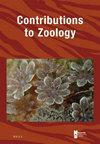加勒比桡足类与礁栖刺胞动物、棘皮动物和海绵动物的研究进展
IF 2.2
2区 生物学
Q1 ZOOLOGY
引用次数: 13
摘要
本综述基于已发表的记录,根据共生桡足类及其宿主的分类、采样地点、坐标、采样深度和日期、文献来源以及最近的三次调查(古巴、东加勒比海的圣尤斯特修斯和南加勒比海的库拉帕拉奥)系统地整理了与大加勒比海的礁栖刺孔动物、海绵动物和棘皮动物相关的桡足类甲壳类动物。共获得3目17科47属115种共栖桡足类532条记录,寄主为80种无脊椎动物,分别为硬核动物(47%)、八爪珊瑚(9%)、棘皮动物(3%)和海绵动物(1%)。在加勒比海的10个生态区中,大安的列斯群岛(有64种共生桡足类)以及南加勒比海和东加勒比海(分别有46种和17种桡足类)是研究最多和最具代表性的,而百慕大只有6种桡足类,加勒比海西南部有一种,墨西哥湾没有。证实了Stock(1988)所指出的加勒比石珊瑚上没有拟足类桡足类动物(拟足科、拟足科和拟足科)。结果表明,目前对加勒比地区共生桡足类的多样性和生态学的研究还很欠缺。本文章由计算机程序翻译,如有差异,请以英文原文为准。
A review of Caribbean Copepoda associated with reef-dwelling cnidarians, echinoderms and sponges
This review of copepod crustaceans associated with reef-dwelling cnidarians, sponges and echinoderms of the Greater Caribbean is based on published records, systematically arranged by the classification of symbiotic copepods and their hosts, sampling sites, coordinates, depth and date of sampling, literature sources, and three recent surveys (Cuba, St. Eustatius in the Eastern Caribbean and Curaçao in the Southern Caribbean). This resulted in totals of 532 records of 115 species of symbiotic copepods (47 genera, 17 families, three orders) hosted by 80 species of invertebrates, representing scleractinians (47%), octocorals (9%), echinoderms (3%), and sponges (1%). Among ten Caribbean ecoregions, the Greater Antilles (with 64 species of symbiotic copepods) as well as the Southern and Eastern Caribbean (with 46 and 17 species of copepods, respectively) are the most studied and best represented, whereas only six species of copepods are known from Bermuda, one from Southwestern Caribbean and none from the Gulf of Mexico. The absence of poecilostomatoid copepods (Anchimolgidae, Rhynchomolgidae and Xarifidae) on Caribbean stony corals as noted by Stock (1988) is confirmed. The results indicate that the diversity and ecology of Caribbean symbiotic copepods are still poorly investigated.
求助全文
通过发布文献求助,成功后即可免费获取论文全文。
去求助
来源期刊

Contributions to Zoology
生物-动物学
CiteScore
4.00
自引率
4.50%
发文量
16
审稿时长
>12 weeks
期刊介绍:
Contributions to Zoology solicits high-quality papers in all systematics-related branches of comparative zoology (including paleozoology). Preference will be given to manuscripts dealing with conceptual issues and to integrative papers (e.g., ecology and biodiversity, morphology and phylogeny and character state evolution, phylogeny and historical biogeography, systematics and bioinformatics, bioinformatics and biodiversity, habitat disturbance and biogeography, etc.). Reviews and alpha-taxonomic contributions are considered for publication, but acceptance will depend on their high quality and exceptional nature.
 求助内容:
求助内容: 应助结果提醒方式:
应助结果提醒方式:


